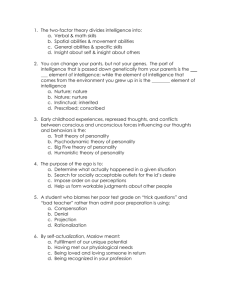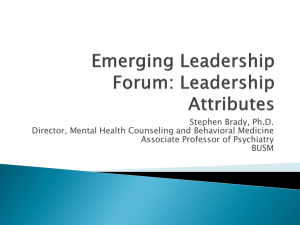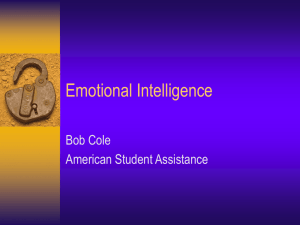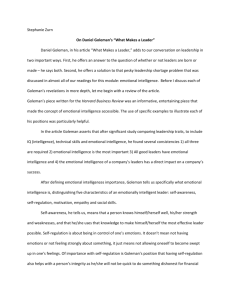r Academy of Management Perspectives 2015, Vol. 29, No. 3. Online only
advertisement
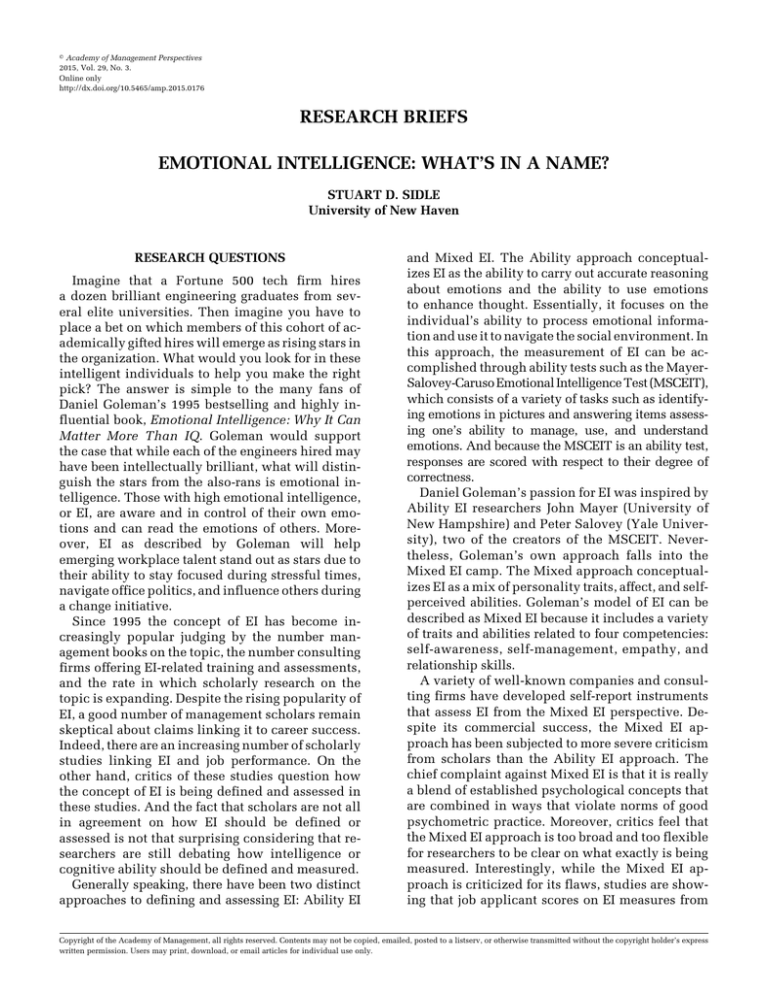
r Academy of Management Perspectives 2015, Vol. 29, No. 3. Online only http://dx.doi.org/10.5465/amp.2015.0176 RESEARCH BRIEFS EMOTIONAL INTELLIGENCE: WHAT’S IN A NAME? STUART D. SIDLE University of New Haven RESEARCH QUESTIONS Imagine that a Fortune 500 tech firm hires a dozen brilliant engineering graduates from several elite universities. Then imagine you have to place a bet on which members of this cohort of academically gifted hires will emerge as rising stars in the organization. What would you look for in these intelligent individuals to help you make the right pick? The answer is simple to the many fans of Daniel Goleman’s 1995 bestselling and highly influential book, Emotional Intelligence: Why It Can Matter More Than IQ. Goleman would support the case that while each of the engineers hired may have been intellectually brilliant, what will distinguish the stars from the also-rans is emotional intelligence. Those with high emotional intelligence, or EI, are aware and in control of their own emotions and can read the emotions of others. Moreover, EI as described by Goleman will help emerging workplace talent stand out as stars due to their ability to stay focused during stressful times, navigate office politics, and influence others during a change initiative. Since 1995 the concept of EI has become increasingly popular judging by the number management books on the topic, the number consulting firms offering EI-related training and assessments, and the rate in which scholarly research on the topic is expanding. Despite the rising popularity of EI, a good number of management scholars remain skeptical about claims linking it to career success. Indeed, there are an increasing number of scholarly studies linking EI and job performance. On the other hand, critics of these studies question how the concept of EI is being defined and assessed in these studies. And the fact that scholars are not all in agreement on how EI should be defined or assessed is not that surprising considering that researchers are still debating how intelligence or cognitive ability should be defined and measured. Generally speaking, there have been two distinct approaches to defining and assessing EI: Ability EI and Mixed EI. The Ability approach conceptualizes EI as the ability to carry out accurate reasoning about emotions and the ability to use emotions to enhance thought. Essentially, it focuses on the individual’s ability to process emotional information and use it to navigate the social environment. In this approach, the measurement of EI can be accomplished through ability tests such as the MayerSalovey-Caruso Emotional Intelligence Test (MSCEIT), which consists of a variety of tasks such as identifying emotions in pictures and answering items assessing one’s ability to manage, use, and understand emotions. And because the MSCEIT is an ability test, responses are scored with respect to their degree of correctness. Daniel Goleman’s passion for EI was inspired by Ability EI researchers John Mayer (University of New Hampshire) and Peter Salovey (Yale University), two of the creators of the MSCEIT. Nevertheless, Goleman’s own approach falls into the Mixed EI camp. The Mixed approach conceptualizes EI as a mix of personality traits, affect, and selfperceived abilities. Goleman’s model of EI can be described as Mixed EI because it includes a variety of traits and abilities related to four competencies: self-awareness, self-management, empathy, and relationship skills. A variety of well-known companies and consulting firms have developed self-report instruments that assess EI from the Mixed EI perspective. Despite its commercial success, the Mixed EI approach has been subjected to more severe criticism from scholars than the Ability EI approach. The chief complaint against Mixed EI is that it is really a blend of established psychological concepts that are combined in ways that violate norms of good psychometric practice. Moreover, critics feel that the Mixed EI approach is too broad and too flexible for researchers to be clear on what exactly is being measured. Interestingly, while the Mixed EI approach is criticized for its flaws, studies are showing that job applicant scores on EI measures from Copyright of the Academy of Management, all rights reserved. Contents may not be copied, emailed, posted to a listserv, or otherwise transmitted without the copyright holder’s express written permission. Users may print, download, or email articles for individual use only. Academy of Management Perspectives the mixed perspective are proving to be strong predictors of job performance. And these relationships are even stronger than those found in studies using assessments from the Ability EI perspective. If the Mixed EI approach is flawed, then why is there mounting evidence of its predictive power? And what is attracting companies and practitioners to selection tools, 360-degree feedback instruments, and training programs based on the Mixed EI approach? Fortunately, new research by Dana L. Joseph (University of Central Florida), Jing Jin and Daniel A. Newman (University of Illinois at Urbana-Champaign), and Ernest H. O’Boyle (University of Iowa) sheds some light on this question. Joseph and her colleagues explored what is actually “in the mix” of Mixed EI to better understand why studies are showing a strong link between Mixed EI and job performance. In a nutshell, they believe the answer comes from breaking down Mixed EI and looking at each of its individual ingredients. Essentially, Joseph and her colleagues hypothesized that Mixed EI measures are actually a blend of well-established personality traits and abilities that have been proven to relate to workplace success. STUDY DESIGN AND METHOD To test their predictions, Joseph and her colleagues analyzed the results of 36 published scholarly studies that examined the connection between Mixed EI and job performance. In doing so, they found it was important to include only Mixed EI studies that assessed actual work performance rather than performance in academic, laboratory, or other simulated contexts. Overall, the combination of studies that Joseph and her colleagues investigated leveraged the collective assessments from over 2,000 employees. KEY FINDINGS The results were fascinating and help unravel the mystery of what comprises Mixed EI. The main ingredients of Mixed EI are the personality variables known as emotional stability (calm, secure, not moody), conscientiousness (organized, careful, self-disciplined, responsible) and extraversion (outgoing, energetic). And Mixed EI also includes facets of Ability EI, namely, cognitive ability, selfefficacy (belief in one’s ability to reach goals), and August an individual’s perceptions of his or her work performance over time. In addition, Joseph and her colleagues discovered why Mixed EI appears to do such an impressive job of predicting actual work performance. Put simply, Mixed EI measures reflect a diverse combination of traits that have long been known to predict job performance individually. For example, research has shown that employees who score high on the personality trait known as conscientiousness are generally more reliable, more motivated, and harder working. Moreover, employees with high self-efficacy tend to be more engaged at work and more easily motivated by challenging goals. Essentially, mixed EI measures are assessing a blend of traits such as extraversion, emotional stability, and conscientiousness, along with self-perceptions and abilities that have already been shown to relate to work performance. And EI was the label put on both this blend and on the more precise concept described as Ability EI. CONCLUSIONS AND IMPLICATIONS Clearly, self-report measures of Mixed EI and Ability EI are not assessing the same concepts. In fact, Joseph and her colleagues argue that Mixed EI models should consider a name change to help differentiate the two. Although Joseph and her colleagues do not offer ideas for a new name, they believe it should describe individuals who are emotionally calm, outgoing, and conscientious, with a positive estimation of their own performance, and [to a lesser extent] emotionally intelligent. And while Joseph and her colleagues recognize theoretical concerns with Mixed EI assessment tools, they do understand why some organizations may see value in their continued use. Indeed, they suggest that practitioners consider using measures of Mixed EI in personnel selection as a shorthand alternative to a lengthy battery of personality and/or ability tests. Depending on the costs of individual tests and the time organizations have to spend on assessing applicants, Mixed EI measures may in some cases serve as an efficient alternative method of assessing applicants’ job-related skills, traits, and abilities with one battery. Overall, Joseph and her colleagues offer some useful insights for practitioners interested in assessing EI but are unsure what type of tool to use. While Ability AI measures do not show as strong of relationship to work performance as Mixed EI 2015 measures, they are more precise in regard to what they are capturing. For instance, if the goal is to help managers understand EI as a form of intelligence and then to leverage well-researched interventions for enhancing it, then Ability EI assessments clearly would be the way to go. On the other hand, if the goal is something broader (e.g., helping managers gain self-awareness around their behavior and personality to enhance the success of their relationships at work), then the broader Mixed EI measures would arguably be a better and more efficient choice. Turning back to the hypothetical question about which of those newly hired brilliant engineers at the tech company are most likely to succeed over the long haul, this research underscores the challenge of coming up with an answer. After all, there appear to be two ways to define and measure EI (Ability EI and Mixed EI). Yet one might be tempted to fall back on those characteristics and abilities that already have an established history as positive predictors of Sidle performance. Put another way, it might be wise just to put the “EI” label aside and focus instead on that ‘basket” of characteristics and abilities that seem to matter most. The best bets for career success might be the engineers who are emotionally stable, outgoing, conscientious, possess a positive estimation of their own performance, and use emotional information to navigate their corporate environments effectively. SOURCE Joseph, D. L., Jin, J., Newman, D. A., & O’Boyle, E. H. (2015). Why does self-reported emotional intelligence predict job performance? A meta-analytic investigation of mixed EI. Journal of Applied Psychology, 100(2), 298–342. REFERENCES Goleman, D. (1995). Emotional intelligence. New York: Bantam.

